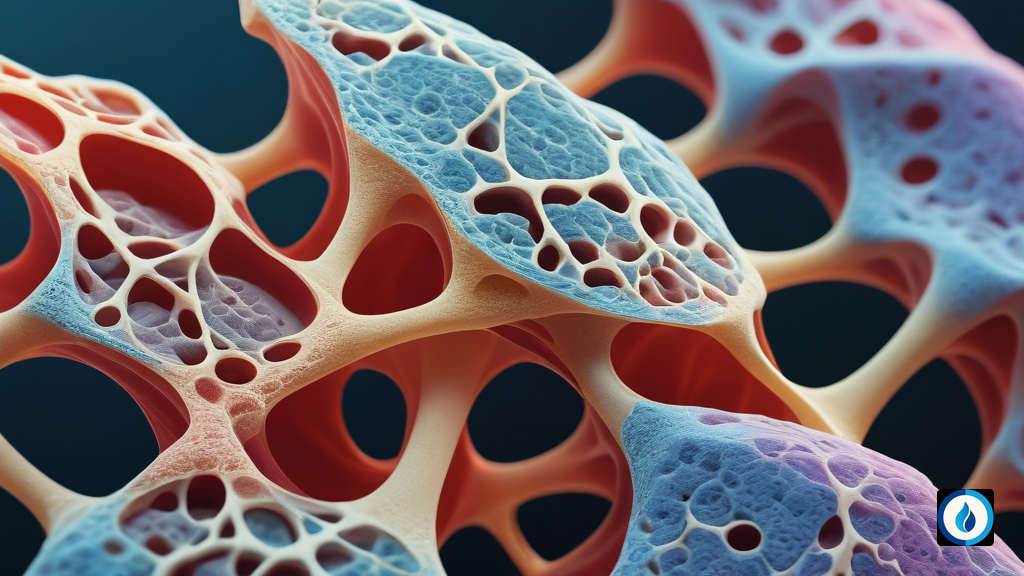H2IntroductionH/2PBone tissue engineering aims to repair or replace damaged or diseased bone using a combination of cells, scaffolds, and bioactive molecules. This study focuses on developing an immunohistochemical (IHC) method to identify and localize osterix, a key transcription factor involved in bone formation, in tissue-engineered constructs composed of human periosteum, electrospun poly-l-lactic acid (PLLA) nanofibers, and polycaprolactone/poly-l-lactic acid (PCL/PLLA) scaffolds.P/H2Materials and MethodsH/2H3Tissue SpecimensH/3PTissue samples were obtained from tissue-engineered bone constructs created using human periosteal tissue, PLLA nanofibers, and PCL/PLLA scaffolds. The constructs were implanted subcutaneously in athymic mice for 10 weeks, allowing for tissue regeneration.P/H3Sectioning and Initial Slide PreparationH/3PAfter retrieval, the constructs were fixed in formalin, embedded in paraffin, and sectioned. Sections were deparaffinized, rehydrated, and subjected to antigen retrieval procedures.P/H3Protease-Induced Epitope RetrievalH/3PProtease-induced epitope retrieval (PIER) was attempted using type 1 collagenase, pronase, and a mixture of both. However, none of these methods successfully revealed the osterix epitope.P/H3Heat-Induced Epitope RetrievalH/3PHeat-induced epitope retrieval (HIER) was performed using various buffers and temperatures. Initially, high temperature (120°C) and pressure (15 psi) in an autoclave yielded positive results but caused tissue damage and section delamination. Subsequently, HIER using sodium citrate/EDTA/Tween 20 buffer at 60°C and normal pressure (15 psi) for 72 hours was found to effectively retrieve the osterix epitope while preserving tissue integrity.P/H3Osterix Antibody LabelingH/3PFollowing epitope retrieval, sections were incubated with a primary antibody specific for human osterix. A dilution of 1:50 was determined to be optimal for antibody binding.P/H2ResultsH/2H3Optimization of IHC ProtocolH/3PHIER using sodium citrate/EDTA/Tween 20 buffer at 60°C and normal pressure for 72 hours was found to be the most effective method for osterix epitope retrieval while preserving tissue structure.P/H3Localization of Osterix-Positive CellsH/3PIHC staining revealed osterix-positive cells within the periosteal tissue, electrospun PLLA nanofibers, and underlying PCL/PLLA scaffolds of the tissue-engineered constructs. This indicates that osteoblasts derived from the periosteum had migrated into and through the nanofiber layer.P/H2DiscussionH/2PThe successful development of an IHC method for osterix identification and localization in tissue-engineered bone constructs provides a valuable tool for assessing the viability and osteogenic potential of these constructs. The optimized HIER protocol using sodium citrate/EDTA/Tween 20 buffer at 60°C and normal pressure for 72 hours effectively reveals the osterix epitope while preserving tissue integrity.P/PThe presence of osterix-positive cells within the nanofiber layer suggests that osteoblasts can migrate through this layer, which could facilitate bone formation and integration of the construct with surrounding tissue.P/PThis study highlights the importance of optimizing IHC protocols for specific proteins and tissue types, especially when dealing with complex specimens containing both tissue and synthetic materials. The optimized protocol developed here can be applied to further investigate the role of osterix in bone regeneration and to evaluate the efficacy of tissue-engineered constructs for bone repair.P/H2AcknowledgmentsH/2PThe authors acknowledge the contributions of Dr. Susan Chubinskaya, the Gift of Hope Organ & Tissue Donor Network, and donor families for providing access to tissue samples.P/H2FootnotesH/2PCompeting Interests: The authors declare no competing interests.P/PAuthor Contributions: PM designed the study, conducted the IHC experiments, analyzed the data, and wrote the manuscript. RJ designed the study, analyzed the data, and wrote the manuscript. QY conducted the IHC experiments, analyzed the data, and wrote the manuscript. WJL designed the study, analyzed the data, and wrote the manuscript. All authors read and approved the final manuscript.P/PFunding: No funding was received for this study.P/
39
